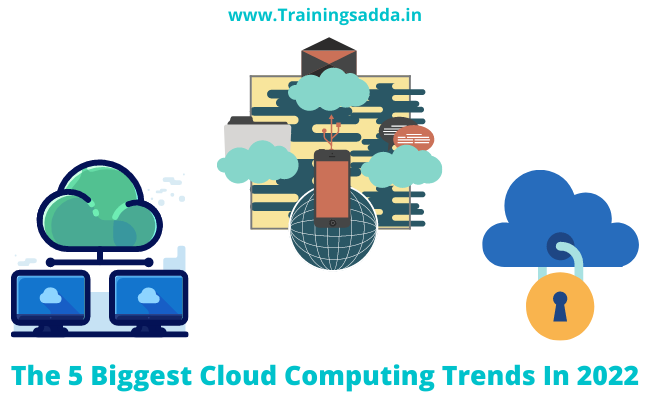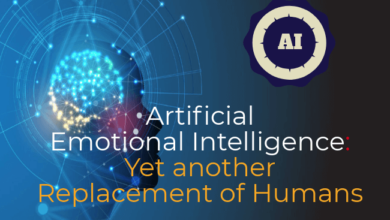The 5 Biggest Cloud Computing Trends In 2022

In this article, we are going to provide knowledge about the 5 largest trends in cloud computing. We will also discuss the 5 different types of cloud computing technologies available in the market at the end of the article. Get this most prominent online Snowflake Training course which is widely used in the technological industry that assists in upgrading your cloud computing skills of Data Warehouses. Now, let’s begin with analyzing the cloud computing trends.
Cloud computing exploded in 2020 & 2021 as enterprises adapted to the worldwide epidemic by concentrating on digital service delivery and as work turned virtual. We will surely witness further rapid acceptance and growth in 2022.
Know more: Best Practices To Keep Your Cloud Environment Secure
It’s likely that the focus will change away from using cloud platforms and tools to better a single function (like switching to Zoom meetings) and toward more comprehensive plans centered on enterprise-wide migration of cloud.
Enhancing the capabilities of hybridized and remote workforces would be an important trend, but data center and cloud architecture will continue to evolve. Here’s my take on some of the most important ways this would happen in 2022.
Table of Contents
The Top 5 Cloud Computing Trends In 2022
1) Cloud consistently improves and expands with amazing new use cases
Global cloud services investment is predicted to reach $482 billion by 2022, up from the $313 billion in the year 2020, as per Gartner. From streaming entertainment and social media to connected automobiles and automated IoT infrastructure, cloud computing infrastructure is the backbone of the delivery pipeline for almost every digital service.
New or prospective ultra-fast networks, such as Wi-Fi 6E and 5G, indicate that not only more data from the cloud would be streamed, but that new forms of data will be streamed as well. This is evidenced by the increased cloud gaming availability systems such as Amazon Luna and Google Stadia, which will receive increased investment until 2022.
Know more: Benefits of 21st Century Technology
Cloud VR/AR will also be available, resulting in smaller and less expensive headsets. From the customer’s perspective, cloud technology makes all other technologies lighter, quicker, and much more accessible, and this truth would be a fundamental driver in the transfer of additional platforms for cloud services.
2) Cloud innovation is increasingly driven by sustainability
Every ethical business recognizes that it has a role to play in addressing climate change’s challenges. In the tech industry, this usually means lowering the energy costs of providing 24/7 “always-on” infrastructure services to customers, as well as minimizing the energy usage related to growing robust computing engines, big digital storage needs, and offering 24/7 “always-on” Customers’ infrastructure services.
The majority of IT giants would spend 2022 putting in place tools and technologies to assist them to meet their net-zero carbon objectives. The world’s largest cloud firm, Amazon is also the world’s largest renewable energy purchaser, with 206 of its own projects of sustainable energy in operation throughout the world, producing approximately 8.5 GW annually.
It is now concentrating on decreasing the “downstream” energy consumption of its devices, such as Fire TV and Echo, once they have been installed in consumers’ homes. Apparently, it’s fantastic that preservation is high on the agenda nowadays, but for firms such as Amazon, the motivations go beyond altruism — the climate change effects are expected to cost enterprises up to $1.6 trillion per annum by 2025, according to estimates.
3) The difference between private and public clouds is blurred in hybrid clouds
Businesses have typically had two alternatives when it comes to cloud migration. They can choose public cloud solutions that are easily available and pay-as-you-go, or private cloud options that are more customizable and adaptable.
For regulatory and security concerns, a private cloud (in which a firm efficiently has its cloud and the data never needs to vacate the premises) is often required. Today, major cloud providers such as IBM, Amazon, and Microsoft are extending their use of models that are “hybrid” which combine the best of both worlds.
Read more: Top 8 Upcoming Technology To See
Data that must be accessed frequently and quickly, such as by customers, could be stored on public Azure or AWS servers and made accessible via tools, apps, and dashboards. Data that is more confidential or mission-critical can be stored on servers that are private with access controlled and processed with proprietary software.
Another factor fueling hybrid cloud’s appeal is that several businesses are moving beyond their initial ventures into cloud computing and are searching for more use cases now that they’ve seen the benefits. As a result, many businesses are now operating in an environment of “multi-cloud, utilizing a variety of services from a variety of vendors. Because of the focus on optimizing the experience of a user and making the stack transparent on the backend when it isn’t needed, a hybrid cloud strategy can lessen the complexity of this.
4) Cloud Computing with AI
In terms of the impact on society, cloud computing takes a critical part in the delivery of AI services, which Sundar Pichai, the CEO of Google has described as “more radical than fire or electricity.” For training and processing data, machine learning systems demand a lot of processing data bandwidth and power, which cloud datacenters make available to anybody.
The majority of “everyday” AI that we watch everywhere around us – from a Google Search to the Instagram filters – is hosted in a cloud, where machine learning is used to route traffic from the data centers to our devices and manage storage capacity. AI and Cloud are closely connected, and this would only get stronger in 2022 and also beyond.
Learn more: What are the differences between Artificial Intelligence and Machine Learning
Algorithms that are “Creative” – productive machine learning that may produce everything from art data to synthetic data for training additional AIs – and language modeling – improving the precision with which robots can interpret human languages – will be big trends in AI. Cloud computing would definitely play a crucial role in both service delivery to customers and constructing the infrastructure required to do so.
5) The Serverless Revolution – Cloud Computing Trends
AWS Lambda, Azure Functions, and Functions of IBM Cloud are among the companies offering serverless cloud services. It’s also known as FaaS, and it refers to the fact that businesses aren’t obligated to lease servers or pay for set quantities of bandwidth or storage.
It provides a true service of pay-as-you-go in which the infrastructure increases transparently as an application’s needs change. In fact, it’s not truly serverless – servers still remain – but it does create another abstraction layer among the platform and the user, removing the need for the user to deal with technicalities and configurations.
Serverless computing in cloud computing would play a significant role in the larger trend of generating new experiences of a user that make innovations more accessible throughout the cloud and the whole digital landscape.
Different Types of Cloud Computing:
The following are five types of Cloud Computing technologies that are frequently used in the market.
Snowflake:
Snowflake is a Data Warehouse solution based on cloud that fully supports ANSI SQL as a SaaS. It also features an architecture that is unique and lets users quickly build tables and begin data queries with little or no assistance from a DBA.
Salesforce:
Salesforce is a well-known CRM platform that establishes a connection between businesses and their customers. The main objective of a company’s salesforce is to aid in the deployment of cloud-based operations such as service as a software (SaaS), product as a software (PaaS), and Internet as a Service (IaaS). We could build any app using Salesforce capabilities and functionalities without spending millions of dollars.
Amazon AWS:
Amazon Web Services (AWS) is a sophisticated, developing cloud computing platform that offers a combination of database infrastructure (IaaS), database framework (PaaS), and bundled service software (SaaS). Operating tools such as computational resources, data storage, and content delivery services may be included in AWS services.
DevOps:
DevOps stands for Development and Operations Collaboration. It’s a combination of Process, People, and Working products that allows for continuous integration and delivery of value to our customers. DevOps expedite the process of delivering the applications and software services at a high pace and high velocity.
Microsoft Azure:
Microsoft Azure, or simply Azure, is a cloud-based computing service for developing, deploying, testing, and managing corporate apps and services. Using cloud-based apps, this solution increases the performance or functionalities of an existing platform. Microsoft Azure was created in 2010 by one of the most well-known software firms, Microsoft Corporations.
Conclusion:
We hope by reading this article, the viewers have understood the trending insights of cloud computing successfully.
Author Bio:
Mohd Jameel, Post graduate in Marketing, Digital Marketing professional at HKR Trainings.
I aspire to learn new things to grow professionally. My articles focus on the latest programming courses and E-Commerce trends.
Comments
0 comments




![How To Fix [pii_email_e6685ca0de00abf1e4d5] Error Code](https://www.trainingsadda.in/wp-content/uploads/2020/10/How-To-Fix-pii_email_e6685ca0de00abf1e4d5-Error-Code-390x220.png)